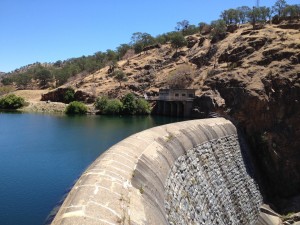
About the only thing most everyone agrees on about salmon on the Tuolumne River is there aren’t as many as there used to be. Disagreements arise when people try to explain why. While there are some exceptions, most of the disputants fall into one of two groups.
The “flow” people argue that dams and consequent reduced flows along rivers during migration have decimated salmon runs. They say that reduced flows lead to loss of spawning habitat and temperatures too high for salmon survival.
The “predation” people argue that salmon populations have fallen because of depredation by striped bass, an introduced species that preys on young salmon.
Both sides have plenty of evidence to support their claims. That’s most likely because both sides are right. The one thing the “predation” people tend to overlook is that reduced flows make predation much easier.
Consider a field full of rabbits. Rabbits are preyed upon by snakes, hawks, foxes, coyotes, weasels, and other predators. As long as the rabbits have places to hide—atriplex, coyote brush, and other dense cover—enough rabbits can elude predators to maintain a viable population. Remove the hiding places, and the rabbit population would soon be devastated beyond recovery.
The situation is much the same with salmon. Reduced flows reduce habitat. That means salmon are concentrated in smaller spaces. They have less room to hide from predators.
Reduced flows also result in lost wetlands. Wetlands provide young salmon refuge from predators. They offer places to rest and build stamina for the long run to the sea. Without places to rest and hide, young salmon are like fish in a barrel. They’re easy prey for any predator, not just striped bass.
Striped bass were introduced in California in 1879. For decades, salmon maintained healthy populations despite the introduced predators. Dams are a different story.
There is a clear relationship between dams and reduced fish populations below the dams, not just in California, but around the nation. In places were dams have been removed, fish populations, including salmon, have made dramatic recoveries.
In the case of the Tuolumne River, it’s not feasible to remove the dams, which include the O’Shaugnessy, Don Pedro, and La Grange dams. However, it is possible to regulate flows along the river in order to enhance salmon survival.
The Federal Energy Regulatory Commission (FERC) monitors environmental consequences of energy production, especially as it relates to dams. During the licensing process, FERC considers the manifold effects of dams on everything from aesthetics to the economy. Two guiding principles are multiple use and the Public Trust Doctrine. FERC has the power to determine beneficial uses of dams, include those involving flows along rivers.
Salmon are a classic multiple use asset. They provide economic, recreational, and aesthetic benefits. No one wants to see salmon reduced to the status of fish in a barrel. Increased flows during migration will set them free.
